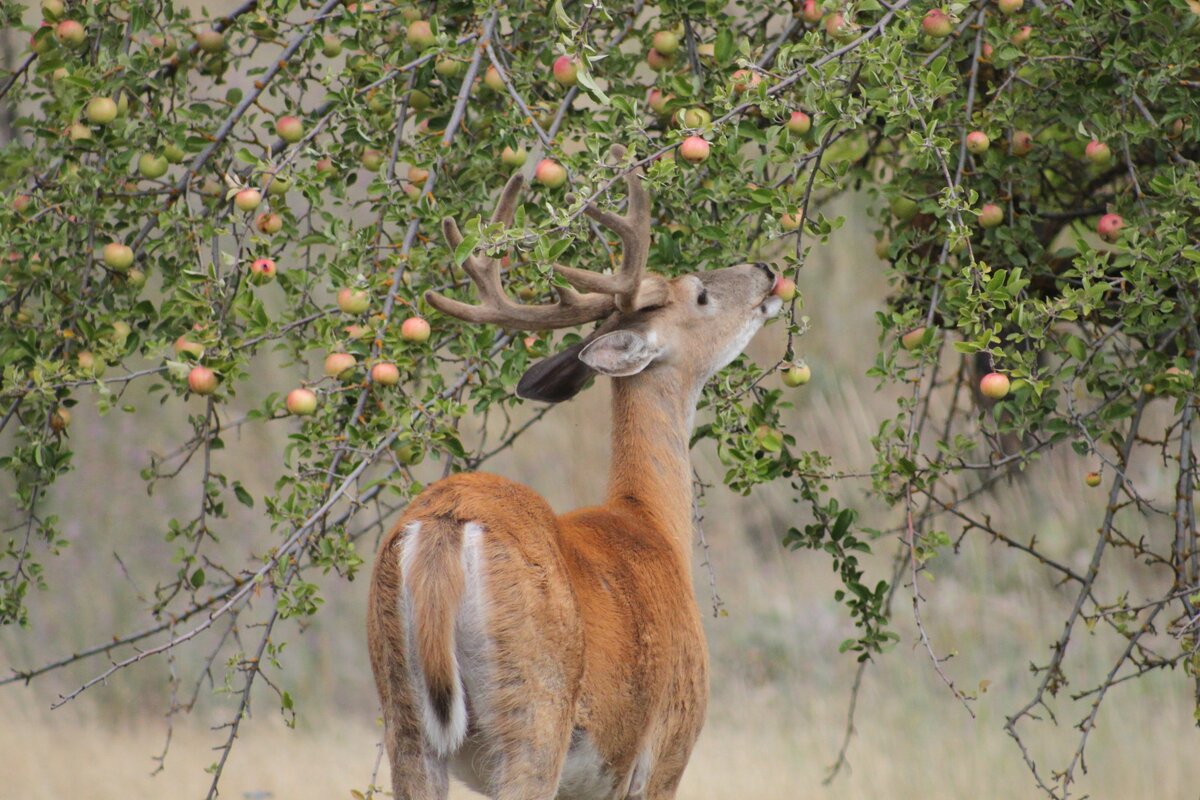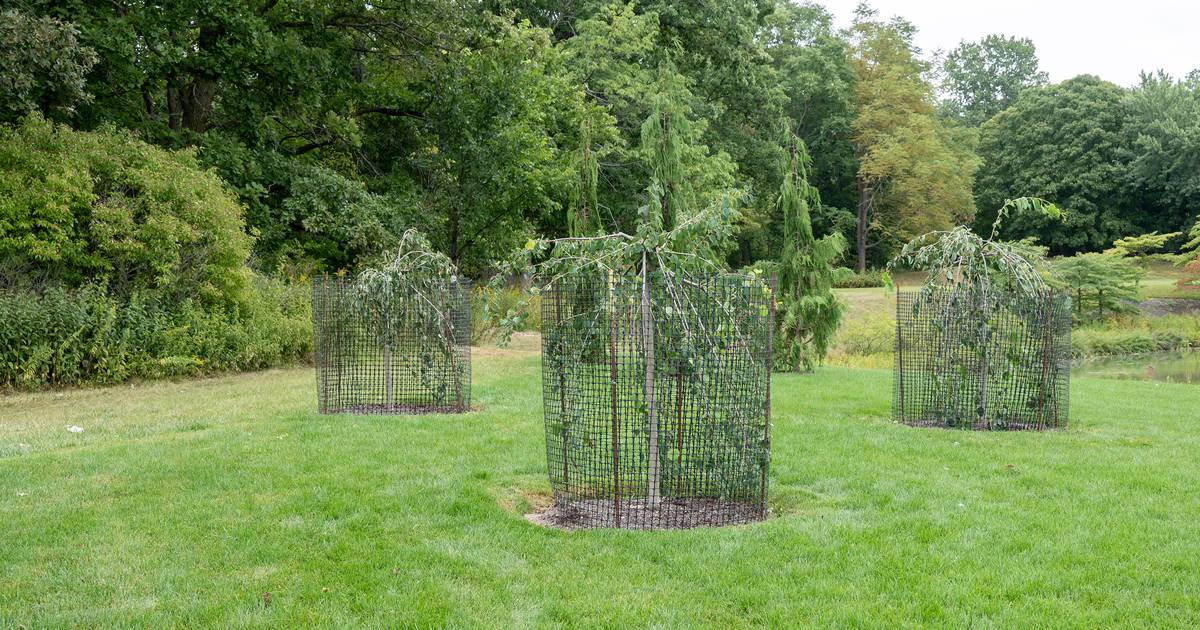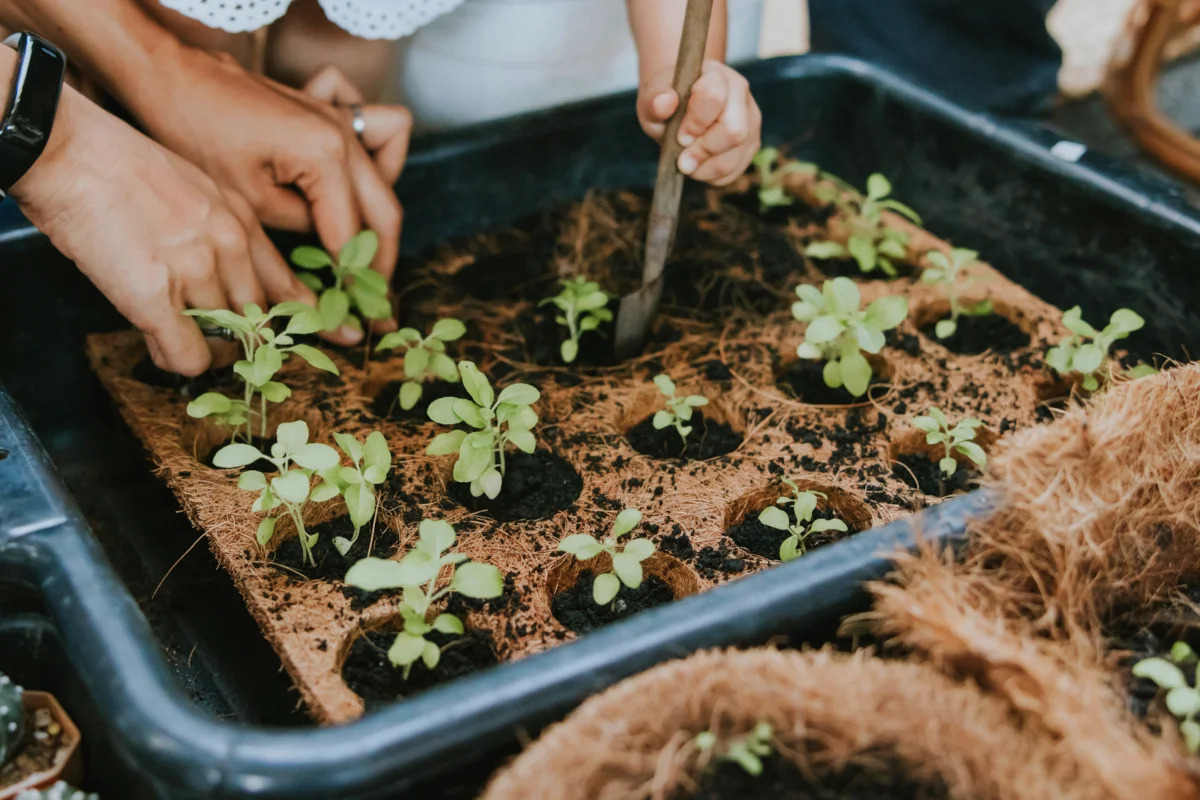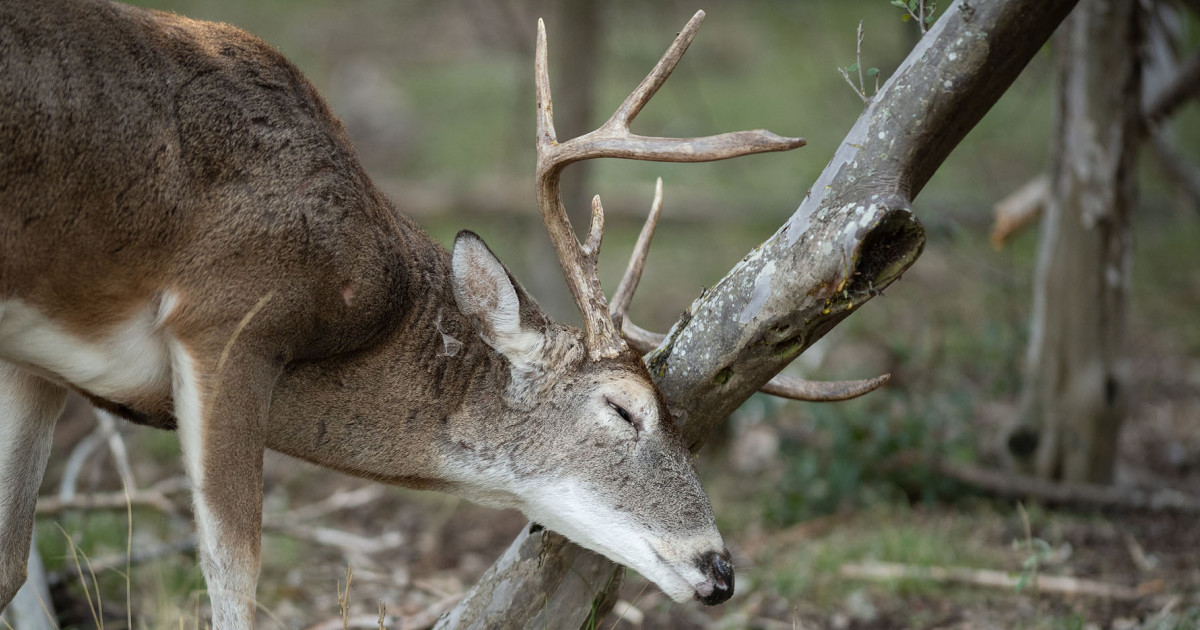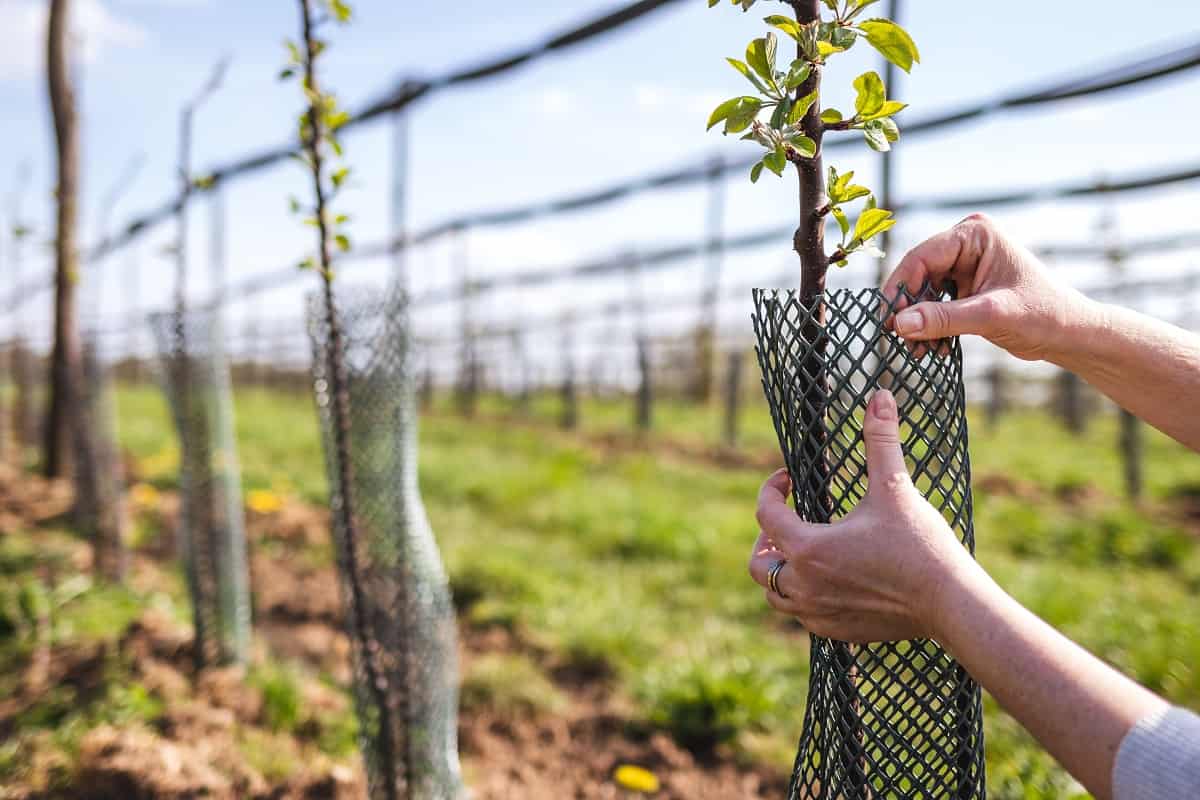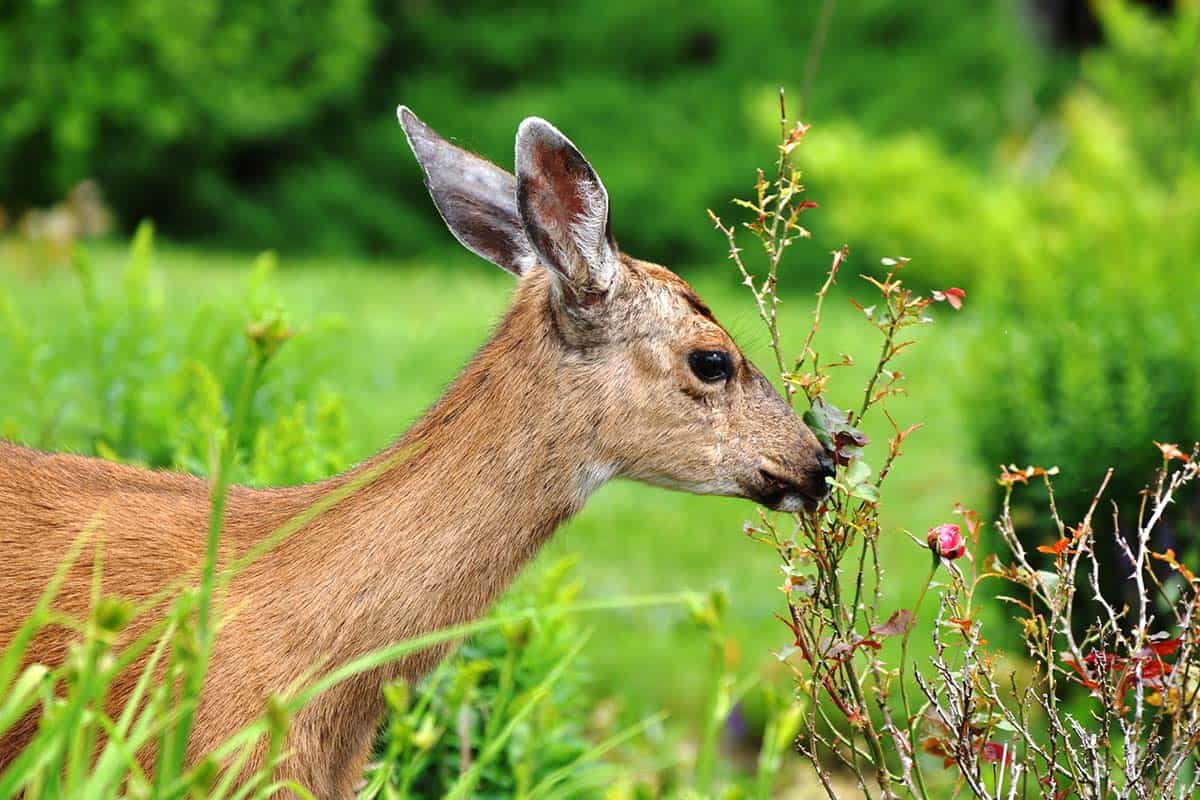Home>Gardening Tips and Tricks>What To Feed Deer In Backyard


Gardening Tips and Tricks
What To Feed Deer In Backyard
Modified: January 22, 2024
Looking to maximize yield and attract deer to your backyard? Discover what to feed deer in your backyard and create a thriving habitat for these majestic creatures.
(Many of the links in this article redirect to a specific reviewed product. Your purchase of these products through affiliate links helps to generate commission for Chicagolandgardening.com, at no extra cost. Learn more)
Table of Contents
Introduction
Welcome to the wonderful world of backyard wildlife! If you’re a nature enthusiast, there’s nothing quite like the joy of observing deer in your own backyard. Not only are they majestic creatures, but they also play a vital role in maintaining a healthy ecosystem. One way to attract and connect with these graceful animals is by providing them with a supplemental food source.
Feeding deer in your backyard can be a rewarding experience, allowing you to observe their feeding habits up close and establish a bond with these enchanting creatures. However, it’s important to approach this endeavor with the right knowledge and considerations. In this article, we will explore the ins and outs of feeding deer in your backyard, from understanding their diet to choosing the right food and implementing best practices.
Before diving into the specifics, it’s crucial to note that feeding deer should only be done as a supplement to their natural diet, especially if you reside in an area where deer are abundant. While it’s tempting to “help” them by providing a consistent food source, it’s important to respect their natural foraging instincts and not rely solely on human-provided sustenance. With that said, let’s delve into the world of deer feeding and discover how to maximize their yield in your backyard.
Understanding the Diet of Deer
Before venturing into feeding deer in your backyard, it’s crucial to have a solid understanding of their natural diet. Deer are herbivores, which means they primarily consume plants, leaves, fruits, nuts, and grasses. Their diet can vary depending on the season and availability of food sources in their natural habitat.
In the spring and summer months, deer feast on tender shoots, leaves, and grasses that are rich in nutrients. As fall approaches, acorns, fruits, and nuts become a significant part of their diet, providing essential fats and energy to prepare for the upcoming winter. During the winter months, when green foliage is scarce, deer rely on browsing on woody vegetation and tree bark to survive.
Understanding the seasonal changes in the natural diet of deer can help guide your efforts in providing supplemental food. By mimicking the nutritional profile of their natural diet, you can ensure that the food you offer meets their dietary needs and maximizes their overall health and well-being.
It’s also important to remember that deer have sensitive digestive systems that are optimized for a high-fiber, low-protein diet. Their long digestive tracts allow them to efficiently extract nutrients from fibrous plant material. Providing a balanced diet that closely resembles their natural food sources can contribute to their overall digestive health and minimize the risk of digestive issues.
Another essential aspect of understanding the diet of deer is recognizing the importance of water. Deer require access to fresh, clean water for drinking and digestion. If you plan to create a feeding area for deer in your backyard, make sure to provide a water source nearby as well.
By understanding the natural diet and feeding requirements of deer, you can better tailor your feeding practices and ensure that the food you offer contributes to their overall health and well-being. In the next section, we will explore the benefits of feeding deer in your backyard.
Benefits of Feeding Deer in Backyard
Feeding deer in your backyard can offer a range of benefits, both for you as a nature enthusiast and for the deer themselves. Let’s explore the advantages of providing a supplemental food source for these beautiful creatures:
- Enhanced Wildlife Viewing: Feeding deer can offer a unique opportunity to observe these magnificent creatures up close. By providing a food source in your backyard, you increase the chances of deer visiting your property, allowing you to witness their natural behaviors and interactions.
- Establishing a Connection with Nature: Feeding deer can foster a deeper connection with the natural world. As you observe and care for the deer that come to your backyard, you develop a greater appreciation for the delicate balance of ecosystems and the importance of wildlife conservation.
- Supporting Deer Health: In certain regions, deer may face food scarcity, especially during the winter months. By providing supplemental food, you can help ensure that deer have enough nourishment to maintain good health throughout the year. This can be particularly beneficial for pregnant does, as they need additional nutrients to support their developing fawns.
- Minimizing Damage to Landscaping: Deer can be notorious for browsing on plants and shrubs, which can lead to damage in gardens and landscapes. By offering a designated feeding area, you can divert their attention from your cherished plants and provide them with a more suitable alternative to satisfy their hunger.
- Educational Opportunities: For families with children, feeding deer can be a valuable educational experience. It provides an opportunity to teach children about wildlife, their dietary needs, and the importance of coexisting with nature. Observing and learning about the behavior of deer can inspire a lifelong interest in conservation and the natural world.
It’s important to note, however, that there are also potential drawbacks and challenges associated with feeding deer. These will be discussed in a later section. Nevertheless, by being aware of these benefits, you can make an informed decision about whether to embark on the journey of feeding deer in your backyard. In the next section, we will explore the different food options available for deer feeding.
Choosing the Right Food for Deer
When it comes to feeding deer in your backyard, it’s important to offer a diet that closely matches their natural food sources. Providing the right food not only ensures that they receive proper nutrition, but it also minimizes the risk of digestive issues and other health problems. Let’s explore the different options for feeding deer:
Natural Foods: One of the best ways to feed deer is by offering natural foods that mimic their diet in the wild. This includes various types of vegetation such as clover, alfalfa, soybeans, and other green plants. Planting a diverse range of deer-friendly plants in your backyard can create a natural buffet for these animals.
Supplemental Foods: In addition to natural foods, there are supplemental food options that you can provide for deer. These foods are specifically formulated to meet their dietary needs. They typically come in the form of pelleted feeds or grain mixes that are high in carbohydrates and proteins. When choosing a commercial deer feed, look for options that have a balanced nutritional profile and avoid those with excessive amounts of fillers or additives.
Fruits and Vegetables: Another option for feeding deer is providing fruits and vegetables. Apples, pears, corn, and carrots are commonly enjoyed by deer and can be offered as occasional treats. However, it’s important to note that fruits and vegetables should never be the sole source of food, as they do not provide the complete nutritional requirements for deer.
Mineral and Salt Blocks: Along with food, deer also require essential minerals to support their overall health. Mineral and salt blocks can be placed in the feeding area to provide deer with necessary nutrients like calcium, phosphorus, and sodium. These blocks should be specifically designed for deer consumption and positioned in an easily accessible location.
Water: While it may not be considered food, water is a crucial element in a deer’s diet. Ensure that a fresh, clean water source is available near the feeding area. This will not only help with hydration but also aid in digestion.
When selecting food options for feeding deer, it’s important to monitor their intake and adjust the quantity accordingly. Overfeeding can lead to reliance on human-provided food and can disrupt their natural foraging behaviors, so it’s crucial to strike a balance. Additionally, it’s important to provide food in a safe and accessible location, away from hazards and potential predators.
By choosing the right food for deer and offering a balanced diet, you can play a role in supporting their overall health and well-being. In the next section, we will explore other supplements that can enhance deer nutrition.
Natural Foods for Deer
When it comes to feeding deer in your backyard, providing natural foods can be an excellent way to supplement their diet and ensure they receive the essential nutrients they need. Offering a variety of natural foods not only supports their health but also encourages their natural foraging behaviors. Let’s explore some of the natural food options that deer find enticing:
- Clover: Clover is a favorite food of deer due to its high protein content. White clover and red clover are both great choices. You can plant clover patches in your backyard to provide deer with a readily available and nutritious food source.
- Alfalfa: Another nutrient-rich food that deer are fond of is alfalfa. It is highly palatable to them and offers a good balance of proteins, carbohydrates, and fiber. Growing small patches of alfalfa can attract deer to your backyard.
- Soybeans: Soybeans are not only a common agricultural crop but also a preferred food source for deer. They are high in protein and highly digestible. Planting soybeans in your backyard can entice deer to visit regularly.
- Green Plants: Deer have a natural affinity for grazing on green plants. They enjoy munching on young shoots, leaves, and grasses. Allowing certain areas of your lawn to grow wild or planting deer-friendly greens such as chicory and ryegrass can provide a natural foraging space for the deer.
- Fruits and Nuts: Deer have a sweet tooth for fruits and nuts. Apples, pears, and persimmons are among their favorites. Likewise, acorns and mast from oak trees are a valuable food source during the fall. If you have fruit or nut trees in your backyard, consider allowing the deer to feast on the fallen fruits and nuts.
Keep in mind that while offering natural foods is beneficial, it should be done in moderation. Feeding deer should supplement their natural diet rather than replacing it entirely. Providing a diverse range of natural foods throughout the seasons will more closely mimic their natural foraging patterns. It’s also important to note that deer have their preferences, and food availability may vary depending on your location and climate.
By incorporating natural food sources into your backyard, you can create a habitat that attracts deer and supports their nutritional needs. In the next section, we will explore an additional option for deer feeding – commercial deer feeds.
Commercial Deer Feeds
Commercial deer feeds are specifically designed to provide the necessary nutrients and energy for deer. They are convenient options for supplementing their diet, especially when natural food sources may be limited or during times of nutritional need. Let’s explore the benefits and considerations of using commercial deer feeds:
Balanced Nutrition: One of the advantages of commercial deer feeds is that they are formulated to provide a balanced nutritional profile for deer. They typically contain a blend of grains, proteins, minerals, and vitamins that closely mimic the deer’s dietary requirements.
Consistent Quality: Commercial deer feeds are produced under controlled conditions, ensuring consistent quality and safety. This means you can rely on the feed to meet the nutritional needs of the deer throughout the feeding season.
Convenience: Commercial deer feeds offer a convenient feeding option for those who may not have access to natural food sources or have limited time and resources for planting and maintaining food plots. They come in pelleted or grain form, making it easy to distribute and monitor their intake.
Supplemental Benefits: Some commercial deer feeds are enriched with added supplements that can provide additional benefits to the deer’s health. These may include additives like probiotics for digestive health or antler-enhancing formulas for antler growth in bucks.
Cost Consideration: While commercial deer feeds can be a convenient option, it’s essential to consider the cost. Feeding deer with commercial feeds can become expensive, especially if you have a large population of deer visiting your backyard regularly. It’s crucial to evaluate your budget and determine if commercial feeds align with your financial means.
Feeding Guidelines: When using commercial deer feeds, it’s important to carefully follow the feeding guidelines provided by the manufacturer. These guidelines typically indicate the recommended quantity of feed based on the number of deer and the time of year. Overfeeding can lead to dependence on the commercial feed and may impact their natural foraging behaviors.
Ultimately, the decision to use commercial deer feeds depends on your specific circumstances and goals. It’s important to strike a balance between natural foods and commercial options to provide a well-rounded diet for the deer. In the next section, we will delve into other supplements that can enhance the overall nutrition of deer in your backyard.
Other Supplements for Deer
In addition to natural foods and commercial deer feeds, there are other supplements that can greatly enhance the nutrition and overall health of deer in your backyard. These supplements offer additional benefits and can help support the well-being of these magnificent animals. Let’s explore some of the other supplements commonly used for deer:
Mineral Blocks and Supplements: Mineral blocks and supplements are essential additions to a deer’s diet. They provide vital minerals such as calcium, phosphorus, and salt, which are necessary for bone development and overall health. Mineral blocks can be placed in the feeding area or strategically positioned around your property to ensure deer have access to these essential nutrients.
Protein Supplements: Protein supplements can be especially beneficial during times of nutritional stress, such as in the winter or during the antler growth period. These supplements are formulated to provide a concentrated amount of protein, helping deer meet their protein requirements for growth and development.
Antler Supplements: For those wishing to promote antler growth in bucks, specifically during the spring and summer, antler supplements can be a valuable addition. These supplements are designed to provide the necessary nutrients and minerals that support antler growth, allowing bucks to develop impressive antlers.
Probiotics and Digestive Aids: Probiotics and digestive aids are becoming increasingly popular in the realm of deer feeding. These supplements help maintain a healthy digestive system by promoting beneficial gut bacteria and aiding digestion. They can improve nutrient absorption and reduce the risk of digestive issues.
Decoy Foods: Decoy foods are supplementary foods that can divert deer away from areas where you don’t want them to forage. These foods, such as corn or other highly palatable items, are strategically placed away from valuable crops or gardens to attract deer and redirect their attention.
Supplemental Feeding Guidelines: When using supplements for deer, it’s important to follow the recommended feeding guidelines provided by the manufacturers. These guidelines will specify the quantity and frequency of supplement usage to avoid overfeeding and ensure the proper balance of nutrients.
Remember, supplements should never be the sole source of nutrition for deer. They should be used to complement a natural diet and provide additional support when needed. As always, it’s crucial to monitor the health of the deer and adjust supplementation as necessary.
In the next section, we will explore best practices and techniques for feeding deer in your backyard to ensure a safe and successful experience.
Feeding Techniques and Best Practices
Feeding deer in your backyard requires careful consideration and adherence to best practices to ensure the well-being of the deer and a positive experience for both you and the animals. Here are some feeding techniques and best practices to follow:
Designated Feeding Area: Establish a designated feeding area in your backyard, away from potential hazards and areas where deer could cause damage. This area can be a patch of natural vegetation or a designated feeding station, providing a safe and controlled space for deer to feed.
Manage Feeding Frequency: It’s important to establish a feeding schedule and stick to it. Regular, consistent feeding times can help deer develop a routine and avoid excessive reliance on the supplemental feed. Feeding once a day in the late afternoon or early evening is a common practice.
Moderate Food Quantity: Avoid overfeeding deer with excessive amounts of food. Providing too much food can lead to a dependence on human-provided feed and may disrupt their natural foraging behaviors. Provide enough food to supplement their diet without creating reliance.
Monitor Food Intake: Keep an eye on the amount of food being consumed by the deer. This can help you adjust the quantity of food being offered, ensuring that you’re providing enough but not overfeeding. Monitoring food intake can also alert you to any potential health issues or changes in appetite.
Protective Netting and Barriers: Use protective netting or barriers to prevent deer from causing damage to your gardens or valuable plants. This can be especially useful if you have areas that you want to keep deer out of, while still providing a designated feeding area nearby.
Water Source: Remember that deer require access to fresh water for hydration and digestion. Make sure a clean water source is available near the feeding area or within a reasonable distance for the deer to access.
Conservation and Wildlife Ethics: Feeding deer should be done with the utmost respect for wildlife and conservation. It’s important to remember that deer should not become reliant solely on human-supplied food. The intention should be to supplement their natural diet and provide additional nutrition when necessary.
Responsible Wildlife Management: Feeding deer should be part of a responsible wildlife management strategy. This may include consulting with local wildlife authorities, understanding and following any regulations or restrictions, and prioritizing the long-term health and welfare of the deer and the ecosystem as a whole.
By following these feeding techniques and best practices, you can create a safe and enriching feeding environment for deer in your backyard. It’s important to be patient and remember that the goal is to enhance their well-being and foster a connection with these magnificent animals.
In the next section, we will address some potential problems that may arise when feeding deer and provide solutions to mitigate these challenges.
Potential Problems and Solutions
Feeding deer in your backyard can sometimes come with a few challenges. Understanding the potential problems that may arise and having solutions in place can help you address these issues effectively. Let’s explore some common problems encountered when feeding deer and discuss potential solutions:
Overpopulation: Feeding deer can inadvertently contribute to overpopulation in certain areas. An excessive deer population can lead to habitat degradation and competition for resources. To avoid this issue, practice responsible wildlife management by monitoring the number of deer visiting your backyard and adjusting the feeding program accordingly. You may consult with local wildlife authorities for guidance on population control methods if necessary.
Damage to Landscaping: Deer are known to browse and graze on plants, which can damage gardens and landscaping. To prevent this, consider using fencing or protective netting to create barriers that deter deer from accessing areas you wish to protect. Creating a designated feeding area away from valuable plants can also divert their attention and reduce grazing in unwanted locations.
Predator Attraction: Feeding deer may inadvertently attract predators to your backyard. To mitigate this, avoid placing food sources near dense vegetation that could provide cover for predators. Monitor the feeding area regularly and take necessary precautions to discourage the presence of predators, such as removing food after feeding times or using motion-activated deterrents if necessary.
Disease Transmission: When deer gather in close proximity around feeding areas, there is a risk of disease transmission. To minimize this risk, ensure that the feeding area remains clean and free of decaying food. Promptly remove any spoiled or contaminated food and regularly clean and sanitize the feeding stations or containers used to prevent the spread of disease among the deer population.
Dependency on Human Feeding: Deer should not become reliant on human-provided food as their sole source of nutrition. To prevent this dependency, gradually reduce the amount of food being offered over time while encouraging natural foraging instincts. Gradually transitioning to a more natural food-focused diet can help ensure the deer maintain their ability to find food in their natural environment.
Unbalanced Diet: If relying solely on commercial or supplemental feeds, there is a risk of an unbalanced diet. To address this, offer a variety of natural food options alongside commercial feeds. This helps provide a more well-rounded diet that includes the necessary nutrients, vitamins, and minerals required for the deer’s overall health and well-being.
Conflicts with Neighbors: Feeding deer in your backyard may occasionally lead to conflicts with neighbors. Some people may not appreciate the presence of deer or the potential damage they can cause. To mitigate these conflicts, communicate with your neighbors about your intentions and address any concerns they may have. Be respectful of their concerns and take measures to minimize the impact of deer feeding on their properties.
By being aware of these potential problems and implementing the suggested solutions, you can navigate any challenges that may arise while feeding deer in your backyard. It’s important to be proactive, adaptable, and responsible in your approach to ensure a harmonious coexistence with these beautiful creatures.
In the concluding section, we will summarize the key points discussed and reinforce the importance of responsible deer feeding practices.
Conclusion
Feeding deer in your backyard can be a rewarding and fulfilling experience, allowing you to connect with nature and observe these graceful creatures up close. However, it’s crucial to approach deer feeding with a deep understanding of their dietary needs and the potential impact on their well-being and the surrounding ecosystem.
Understanding the natural diet of deer and providing a diverse range of natural foods, such as clover, alfalfa, and fruits, can help supplement their nutritional needs and promote their overall health. Additionally, incorporating commercial deer feeds and other supplements, such as mineral blocks and protein supplements, can further enhance their nutrition, particularly during times of scarcity or specific nutritional requirements.
Implementing best practices, including creating designated feeding areas, managing feeding frequency, and monitoring food intake, can help ensure a balanced and responsible approach to deer feeding. It’s important to remember that deer should not become overly dependent on human-provided food and that their natural foraging behaviors should be respected and encouraged.
While there may be challenges and potential problems like overpopulation, damage to landscaping, and disease transmission, there are solutions available. Practicing responsible wildlife management, using protective measures, maintaining cleanliness, and reducing dependency on human feeding can help address these issues and create a safe and harmonious environment for both deer and humans.
Ultimately, feeding deer in your backyard should be done with a deep respect for wildlife and a commitment to conservation. It’s a chance to observe and appreciate the beauty of nature while actively contributing to the well-being of these magnificent animals.
So, if you’re ready to embark on the journey of feeding deer in your backyard, remember to do so with careful consideration, knowledge, and a sense of stewardship. By adhering to best practices, monitoring their diet and well-being, and promoting responsible wildlife management, you can create a haven for deer and foster a deeper connection with the incredible world of nature that surrounds us.


